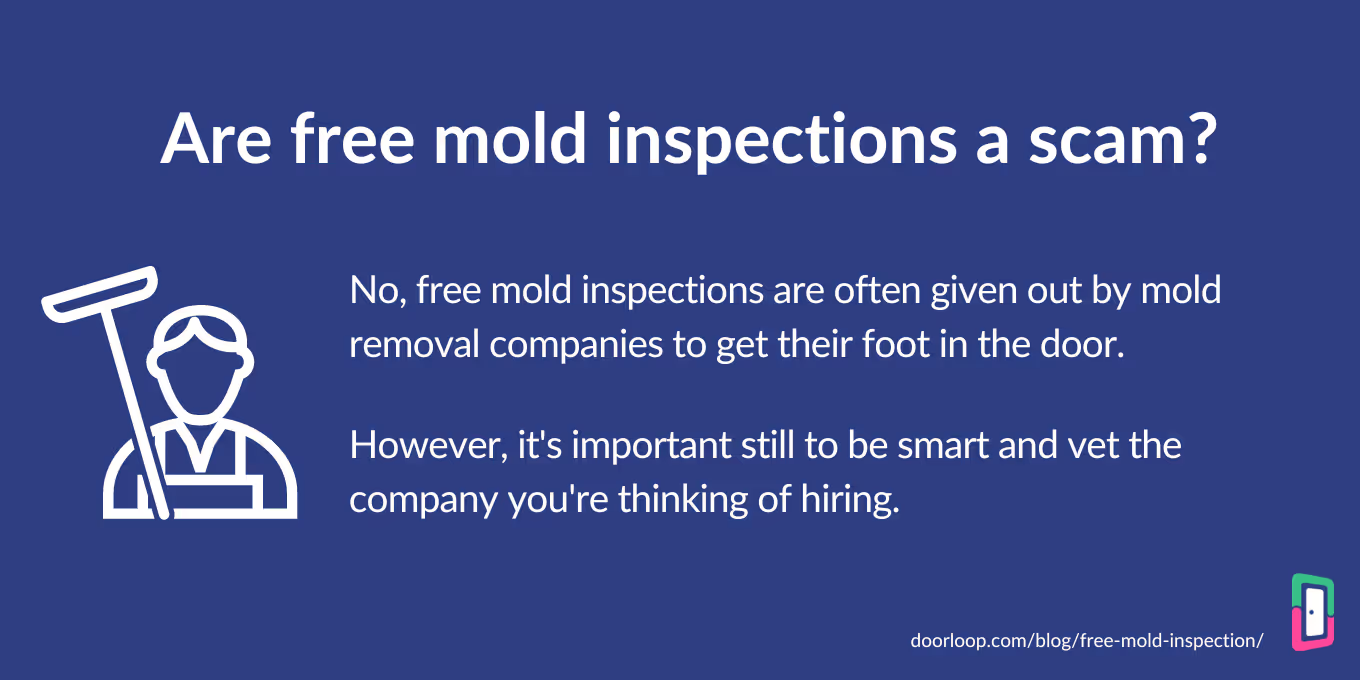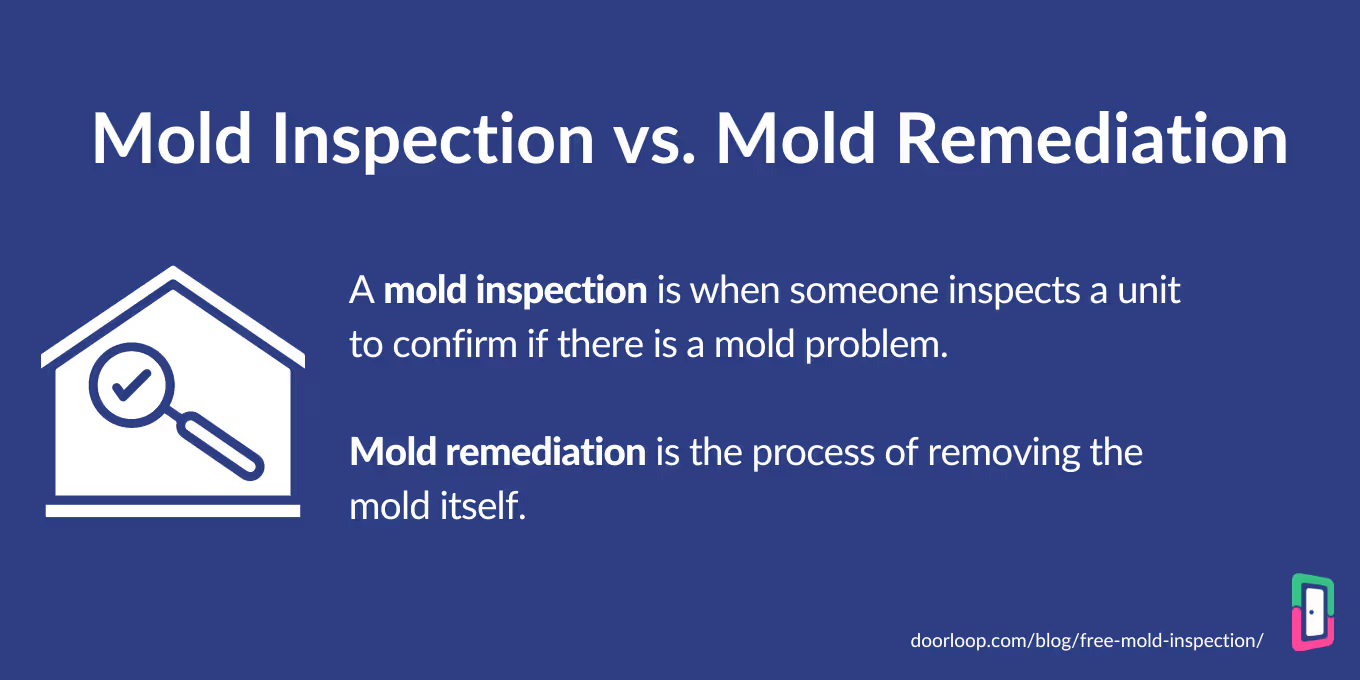Will the mold spores produce more mold?
Will I have issues with the property?
Do I have to call mold inspectors and will it be a visual inspection or further mold testing?
How much does a mold inspection cost?
How quickly can I rent out the unit after getting rid of the mold (if it’s vacant)?
Fortunately, free mold inspections are a thing (though you’ll need to pay to take care of any mold problems if the inspector finds something).
So, it should generally cost you nothing to find out if you have a problem.
You could also handle the mold problem, depending on the issue, but more on that later.
Before we get ahead of ourselves, let’s start from the top.
If you’ve never dealt with a mold problem before and you’re not convinced it’s something you should take care of ASAP, let’s talk a little about why.
Then, we’ll talk about everything from:
- Hiring a mold inspector and remediation
- How long you have to fix the problem
- What to do if you find mold in one of your units
- And factors that can cause mold so that you can take preventative measures
Let’s get started.

Why is apartment mold a problem?
Mold is a problem for tenants because it’s a major health risk.
Potential risks linked to mold exposure include:
- Respiratory infections and other breathing difficulties
- Asthma attacks and new asthma diagnosis in those without it
- Bleeding in lungs
- Eczema and other skin-related issues
- Allergic reactions
However, that’s not all.
Mold is a problem for landlords for more than just that. It’s an additional risk to you because mold can spread and damage the property and even carpet and furniture depending on where it spreads.

Is a free professional mold inspection a scam?
We touched on this earlier since it’s the major question, but let’s talk about it in more detail now.
No, free mold inspections are not a scam.
Free mold inspections are an example of a common strategy in sales where businesses offer something for free to provide initial value and get their ‘foot in the door’ so to speak.
It’s hard to be convinced to pay for a mold inspection if you’re not even sure you have a mold problem in the first place.
How would you feel if you paid a mold removal company and it turned out you didn’t have a mold problem?
You probably wouldn’t have a very good memory of the company, because you’d feel like you wasted money.
Instead, mold removal companies make their money on mold remediation, or the removal of the mold itself.
Having said that, there have been examples of mold companies scamming landlords by taking advantage of this system.
So, make sure to be clear on pricing before having the company visit the property in the event that they can show that there is a mold problem.

Mold inspection vs. Mold remediation
In mold removal, the words “inspection” and especially “remediation” are thrown around without most consumers really being clear what the difference is.
So, let’s cover that now:
Mold inspection
A mold inspection is simply the inspection a mold removal company performs to evaluate if the property or unit does in fact have a mold problem or not.
This involves the physical checking and testing of the unit by a mold removal specialist at the property.
Typically, mold inspections take 1-2 hours.
Mold remediation
This is the next step. Mold remediation is simply the term used to refer to the process of removing the mold itself.
Typically, mold remediation is what you’d be paying for after receiving a free inspection.
What exactly that fix is will depend on what your problem is and how pervasive, but it is always referred to under the greater umbrella of ‘mold remediation’.
What to do if there’s mold in your rental
Now that the basic questions of why and what are out of the way, let’s talk about what you should do.
Some landlords may want to try and handle the issue themselves when they find potential mold in one of their units (or are notified by a tenant).
You can, but be careful.
Mold removal typically can’t be handled simply with “a little bleach cleaner and call it a day”-type treatment unless it’s very small (such as a bit of mold between cracks in restroom tile).
That’s partly because the treatment usually then has to be paired with preventative measures as well such as removing the source of moisture.
Due to the nature of mold (i.e. it spreads) most places you may find mold will be hard to see.
So, by the time you or your tenant finds it, the mold may have spread to the other side of the wall or another location not easily visible.
With that said, you can handle mold yourself if you’re careful and the issue hasn’t spread too far.
For a more detailed guide on both removing and preventing mold in your properties, follow our guide: Mold In Rental Properties: Guide To Removing And Preventing.
How long does a landlord have to fix a mold problem?
The simple answer is: it all depends on your local laws.
You’ll want to check with your official state and local resources to confirm what the law says in your area as every state is different.
However, so that you have an idea of what those laws could look like, let’s talk about California as an example.
In CA, a tenant must send a written complaint notifying you of the mold problem.
Once that notification has been sent, landlords in California have 30 days from the receipt of that notification to respond and fix the mold problem.
Again, it’s vital that you check your state and local laws, though, to ensure you’re in line with legislation in your area.
Factors that can cause mold to grow
Now, let’s talk preventative measures.
The first step to preventing mold is to understand what causes mold to grow.
If you know that, you’re one step ahead and can greatly reduce the chance that it grows in the first place (or grows back).
The first and most important thing to understand is that:
- Mold grows due to dampness
- Especially in areas without enough ventilation
Mold needs a wet surface to grow, so any surfaces where small traces of water are left sitting for long periods of time are prime targets.
Hence why the shower is the one place in the average home where mold is often seen.
However, those are easy to catch and handle regularly with a little bleach cleaner.
The bigger problem areas are:
- Leaky pipes, especially inside walls
- Condensation on walls and windows
- Leaky roof
- Water drains or anywhere that water collects
Proper plumbing and regular checks to your plumbing system can really go a long way here, as they’ll usually catch any leaks far before mold becomes a problem.
However, for more on preventing mold, check out our guide: Mold In Rental Properties: Guide To Removing And Preventing.
































.svg)
.svg)

